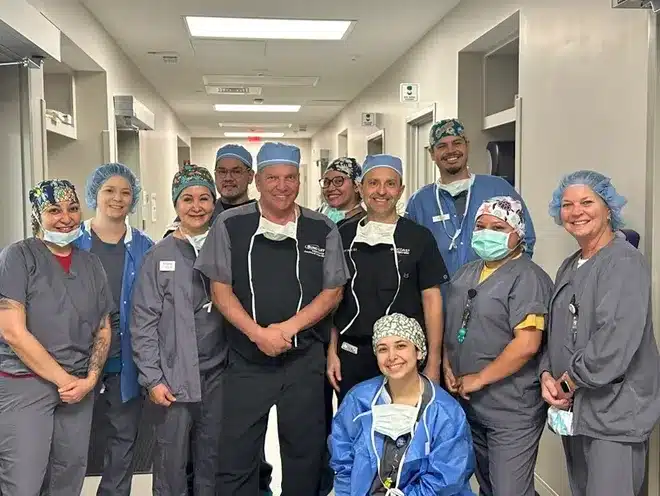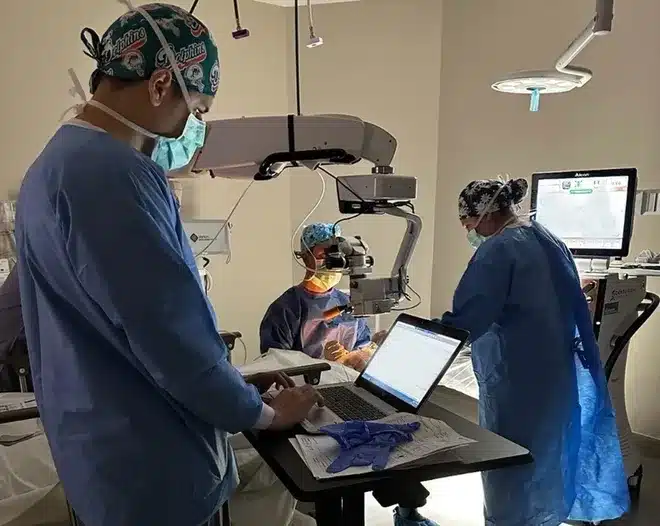
REFRACTIVE LENS EXCHANGE (RLE): An Effective Elective For Better Vision!
For over 30 years, Frantz EyeCare has established itself as the leader in Southwest Florida for physician-led, multispecialty eye care. Dr. Jonathan Frantz has been practicing for over 35 years, and has performed over 75,000 successful eye surgeries. He and his team of highly-trained surgical specialists have a total eye care approach to patient treatment, which is why Frantz EyeCare’s satisfaction rate is so high.
While the practice is widely known for Cataract and LASIK surgery as well as the treatment of eye disease, another vision correction procedure has risen in popularity in recent years – Refractive Lens Exchange (RLE).

WHAT IS REFRACTIVE LENS EXCHANGE (RLE)?
Refractive Lens Exchange (RLE) is an elective outpatient procedure that is ideal for candidates who are usually between the ages of 40 and 60 and want to get rid of their bifocals and reading glasses. During an RLE surgery, a surgical specialist removes the eye’s natural lens and replaces the lens with an intraocular lens (IOL) that has a customized prescription to correct the patient’s vision.
RLE is an alternative to laser vision correction procedures such as LASIK, KLex/SMILE, and PRK which change the shape of the cornea in order to correct vision. While laser vision correction can be a great solution for individuals in their 40’s, it will only address the cornea’s shape and not the lens inside the eye.
A Refractive Lens Exchange (RLE) procedure can provide better vision to patients who are nearsighted, farsighted, and/or in need of astigmatism correction. Ideal candidates should have no history of eye disease or complications that would prove to increase risks such as retinal detachment, uveitis, diabetic retinopathy or age-related macular degeneration.
REFRACTIVE LENS EXCHANGE OPTIONS
Frantz EyeCare offers the most advanced lens technology in the industry and provides patients with customized solutions designed specifically to meet the needs of their individual eyes. RLE options for patients include:
- LAL (Light Adjustable Lens™) – The power of this lens can be adjusted after surgery non-invasively in order to customize the lens to fit the prescription needs of the patient.
- PanOptix® – This lens can give patients clear vision at near, far, and intermediate distances and was the first trifocal lens implant used in the United States.
- Vivity® – This lens provides patients with an extended depth of focus and is a great option for individuals who need a solution for dependable night driving.
- Monofocal (Basic or Toric) – A lens that offers clear vision to patients at a single point of focus (usually distance). The toric monofocal lens provides astigmatism correction.
- Monovision – The vision of the dominant eye is corrected for distance while the other eye is corrected for near and intermediate distances.
THE RISKS & BENEFITS OF RLE
The key benefit of RLE is that this procedure can correct all types of refractive errors. Post-operatively, patients either experience freedom from glasses and contacts, or much less reliance on glasses – depending on the type of lens that they choose. Most patients experience vision improvement within 24 hours of their procedure.
An additional benefit is that once a patient has had refractive lens exchange, they will not develop cataracts later in life. Cataracts cannot form once the natural lens of the eye is removed.
As with any surgical procedure, there is a minimal amount of risk involved – but it is no riskier than cataract surgery. While 95% of RLE patients experience glasses-free driving vision or better, it is important to remember that individual eye health plays a role in every procedure. Compliance with post-operative care is important, so mutual communication between the surgeon and patient is important so as to ensure that each patient feels confident in the care that is being provided.
Refractive Lens Exchange has become more popular as frustration with readers and bifocals has continued to grow over the years. Increasingly, patients are seeking lifestyle solutions that reduce their dependence on glasses and contacts. Because cataracts can begin to develop in a patient’s 40’s and 50’s, RLE is also a great option for cataract prevention in addition to providing clear vision at multiple distances.
To learn more about Frantz EyeCare and schedule an appointment, visit www.bettervision.net.
